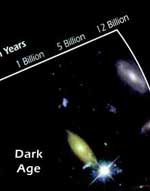
Image credit: NASA
Astronomers who want to study the early universe face a fundamental problem. How do you observe what existed during the “dark ages,” before the first stars formed to light it up? Theorists Abraham Loeb and Matias Zaldarriaga (Harvard-Smithsonian Center for Astrophysics) have found a solution. They calculated that astronomers can detect the first atoms in the early universe by looking for the shadows they cast.
To see the shadows, an observer must study the cosmic microwave background (CMB) – radiation left over from the era of recombination. When the universe was about 370,000 years old, it cooled enough for electrons and protons to unite, recombining into neutral hydrogen atoms and allowing the relic CMB radiation from the Big Bang to travel almost unimpeded across the cosmos for the past 13 billion years.
Over time, some of the CMB photons encountered clumps of hydrogen gas and were absorbed. By looking for regions with fewer photons – regions that are shadowed by hydrogen – astronomers can determine the distribution of matter in the very early universe.
“There is an enormous amount of information imprinted on the microwave sky that could teach us about the initial conditions of the universe with exquisite precision,” said Loeb.
Inflation and Dark Matter
To absorb CMB photons, the hydrogen temperature (specifically its excitation temperature) must be lower than the temperature of the CMB radiation – conditions that existed only when the universe was between 20 and 100 million years old (age of Universe: 13.7 billion years). Coincidentally, this is also well before the formation of any stars or galaxies, opening a unique window into the so-called “dark ages.”
Studying CMB shadows also allows astronomers to observe much smaller structures than was possible previously using instruments like the Wilkinson Microwave Anisotropy Probe (WMAP) satellite. The shadow technique can detect hydrogen clumps as small as 30,000 light-years across in the present-day universe, or the equivalent of only 300 light-years across in the primordial universe. (The scale has grown larger as the universe expanded.) Such resolution is a factor of 1000 times better than the resolution of WMAP.
“This method offers a window into the physics of the very early universe, namely the epoch of inflation during which fluctuations in the distribution of matter are believed to have been produced. Moreover, we could determine whether neutrinos or some unknown type of particle contribute substantially to the amount of ‘dark matter’ in the universe. These questions – what happened during the epoch of inflation and what is dark matter – are key problems in modern cosmology whose answers will yield fundamental insights into the nature of the universe,” said Loeb.
An Observational Challenge
Hydrogen atoms absorb CMB photons at a specific wavelength of 21 centimeters (8 inches). The expansion of the universe stretches the wavelength in a phenomenon called redshifting (because a longer wavelength is redder). Therefore, to observe 21-cm absorption from the early universe, astronomers must look at longer wavelengths of 6 to 21 meters (20 to 70 feet), in the radio portion of the electromagnetic spectrum.
Observing CMB shadows at radio wavelengths will be difficult due to interference by foreground sky sources. To gather accurate data, astronomers will have to use the next generation of radio telescopes, such as the Low Frequency Array (LOFAR) and the Square Kilometer Array (SKA). Although the observations will be a challenge, the potential payoff is great.
“There’s a gold mine of information out there waiting to be extracted. While its full detection may be experimentally challenging, it’s rewarding to know that it exists and that we can attempt to measure it in the near future,” said Loeb.
This research will be published in an upcoming issue of Physical Review Letters, and currently is available online at http://arxiv.org/abs/astro-ph/0312134.
Headquartered in Cambridge, Mass., the Harvard-Smithsonian Center for Astrophysics is a joint collaboration between the Smithsonian Astrophysical Observatory and the Harvard College Observatory. CfA scientists, organized into six research divisions, study the origin, evolution and ultimate fate of the universe.
Original Source: Harvard CfA News Release
